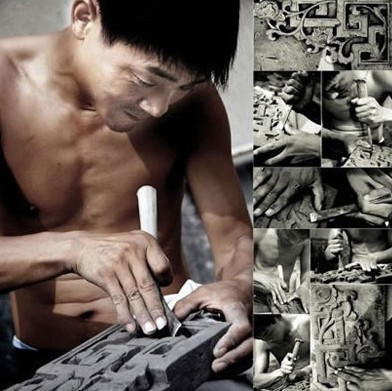Artisans play significant role in cultural heritage preservation and protection

Brick carving is an artistic skill. But as times change, it becomes increasingly challenging to integrate traditional artisans' skills into modern life.
Traditional artisans, particularly those involved in making handicraft items, are one of the main conduits through which intangible cultural heritage skills are passed down. These handicraft artisans used to live in villages and played a significant role in the lives of local people. But the changes in society brought by development have disrupted the cultures of traditional rural communities.
Urbanization and modernization are placing constant strain on intangible cultural heritage, and modern, commercial lifestyles often conflict with the needs of intangible heritage preservation.
In recent years, the nation has begun to recognize and support inheritors of traditional skills because they are living carriers of traditional skills with cultural significance. But the difficulties of protecting traditional skills are deceptively complicated.
Recognizing these artisans for the skills they have inherited is not enough to guarantee the sustainability of traditional skills. The intrinsic rules and requirements of these skills must also be considered.
The ways in which skills are passed down are important as well. The knowledge of artisans can be passed down in various ways, such as oral instruction and hands-on learning.
In the context of the traditional agrarian economy, the handicraft industry’s development was extremely stable and skills were passed on in an orderly way. In most industries, venerated masters could establish their own systems of knowledge that formed a basis for teaching disciples. The results depended on the masters’ scope of knowledge, their willingness to teach, and the competence of disciples.
The knowledge of artisans cannot always simply be explained, and sometimes disciples need a tactile experience. In many cases, artisans prefer to stick to traditional methods of teaching a disciple.
A number of craftsmen live in relatively closed regional cultural circles and stick to traditional craft processes that have been passed on through generations, and thus maintained a certain authenticity. But this process was more suited to the thousands of years when China was an agrarian society.
With the passage of the time, the cultural soil that traditional craftsmen require has been eroded. Knowledge and skills that could not be adapted to the times have died out, causing crises in cultural heritage inheritance. This is not only caused by time, but also the primitive knowledge transmission systems of artisans.Ultimately, integrating traditions with new knowledge is the best way to ensure the knowledge of artisans is preserved.
Although traditions are in a sense defined as the opposite of new knowledge, traditions in handicraft knowledge systems embody rich traditional resources, which are the roots of Chinese culture. Absorbing new knowledge does not have to mean these artisans give up traditional skills, rather, this process can help them better integrate these skills into modern life, thus realizing positive development.
Sun Facheng is from the School of Creative Culture and Communication at Zhejiang Normal University.
